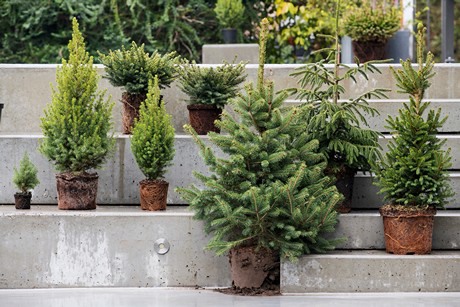Spruce (Picea) and fir tree (Abies) are the real stars in December, but don’t overlook what they can offer during the rest of the year in terms of greenery and interesting points of focus in the garden. The range is extensive, and every pine tree has its own personality. There are species that look like they’ve come straight from a Japanese garden, interesting silhouettes with hanging branches for a bit of theatre on the patio, and beautiful full fir trees with a bluish grey tone that lights up beautifully in the moonlight. Even without decorations or fairy lights they already look stunning, and they offer constant greenery in the garden throughout the rest of the year as well.

Credit: Thejoyofplants.co.uk
Origin
Fir trees grow in the Caucasus and Asia Minor, other species also grow in Korea, Japan and North America. Spruce is native to large parts of northern, central and eastern Europe and large areas of Asia.
Festive Pines assortment
Spruce is officially a hardy needle conifer, but it looks like a true pine tree, often complete with cones below the branches. It can have a classic pine shape, with layered branches that stretch out around the stem, but they can also be spherical, trained as a pyramid or have hanging branches. A selection is described below.
Norway spruce (Picea abies) is the most commonly sold spruce. The tree is often offered without roots which means it needs to be placed on a wooden cross or Christmas tree stand. This classic Christmas tree starts at 50 cm. The decorative value is particularly determined by the arrangement of the branches and the tree’s shape. The disadvantage of this species is that it often sheds a lot of needles after a while. Placing the spruce in a stand with water or choosing a tree with roots can delay this process.
White spruce (Picea glauca 'Conica') is an attractive, compact, pyramidical tree. The needles are green and densely packed and the tree grows slowly. Characteristics: prone to aphids, needles pointing in all directions with a rough twig, smells like blackcurrants. Some larger sizes are grown in the field and are then placed in pots. Most of the smaller sizes are grown in pots and sell well in flower shops because of their attractive smaller, manageable size. It’s the ideal mini Christmas tree for use as a ready-decorated tree.
Serbian spruce (Picea omorika) is a slender upright yet compact Christmas tree with elegant branches. Needles are 1 to 2 cm, bright green on top and blue underneath, lending a blue tone to the tree. The needles stay on the tree better than with a Norwegian spruce. Rooted trees can be used after Christmas as an attractive solitary tree in the garden, which can reach a height of 8 to 10 metres.
The fir tree has long, flat needles. The colour is greyish green, sometimes with a silvery tone. Fir trees have cones on the branches that partly fall apart, leaving the core standing. Depending on the species it can grow in a narrow pillar shape or in a classic Christmas tree form. The three most important are listed below:
Nordmann fir (Abies nordmanniana) is increasingly being sold as a Christmas tree, and is also used widely for festive foliage. A slightly more expensive tree, but very decorative with its shiny dark green top surface and grey underside. The tree suffers less needle shed, and has an attractive arrangement of the branches for positioning decorations and lights. Planting rooted trees in the garden later is possible, but be aware that Nordmann can reach a height of 20 metres.
Noble fir (Abies procera ‘Glauca’) has an attractive bluish green colour, coarse, soft needles and a strong fresh scent. This species is often used at Christmas.
Korean fir (Abies koreana) is an exceptionally attractive Christmas tree that may already be bearing indigo cones at the selling stage, unlike other Christmas trees. The needles are shiny green on top and have a silvery white underside.
For more information:
Thejoyofplants.co.uk
